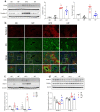Intermittent Fasting Attenuates Metabolic-Dysfunction-Associated Steatohepatitis by Enhancing the Hepatic Autophagy-Lysosome Pathway
- PMID: 37960230
- PMCID: PMC10649202
- DOI: 10.3390/nu15214574
Intermittent Fasting Attenuates Metabolic-Dysfunction-Associated Steatohepatitis by Enhancing the Hepatic Autophagy-Lysosome Pathway
Abstract
An intermittent fasting (IF) regimen has been shown to protect against metabolic dysfunction-associated steatohepatitis (MASH). However, the precise mechanism remains unclear. Here, we explored how IF reduced hepatic lipid accumulation, inflammation, and fibrosis in mice with MASH. The mice were fed a high-fat diet (HFD) for 30 weeks and either continued on the HFD or were subjected to IF for the final 22 weeks. IF reduced body weight, insulin resistance, and hepatic lipid accumulation in HFD-fed mice. Lipidome analysis revealed that IF modified HFD-induced hepatic lipid composition. In particular, HFD-induced impaired autophagic flux was reversed by IF. The decreased hepatic lysosome-associated membrane protein 1 level in HFD-fed mice was upregulated in HFD+IF-fed mice. However, increased hepatic lysosomal acid lipase protein levels in HFD-fed mice were reduced by IF. IF attenuated HFD-induced hepatic inflammation and galectin-3-positive Kupffer cells. In addition to the increases in hepatic hydroxyproline and lumican levels, lipocalin-2-mediated signaling was reversed in HFD-fed mice by IF. Taken together, our findings indicate that the enhancement of the autophagy-lysosomal pathway may be a critical mechanism of MASH reduction by IF.
Keywords: autophagy; intermittent fasting; lysosome; non-alcoholic steatohepatitis.
Conflict of interest statement
The authors declare no conflict of interest.
Figures






References
-
- Eslam M., Newsome P.N., Sarin S.K., Anstee Q.M., Targher G., Romero-Gomez M., Zelber-Sagi S., Wong V.W.-S., Dufour J.F., Schattenberg J.M., et al. A new definition for metabolic dysfunction-associated fatty liver disease: An international expert consensus statement. J. Hepatol. 2020;73:202–209. doi: 10.1016/j.jhep.2020.03.039. - DOI - PubMed
MeSH terms
Substances
Grants and funding
LinkOut - more resources
Full Text Sources
Medical
Research Materials
Miscellaneous

